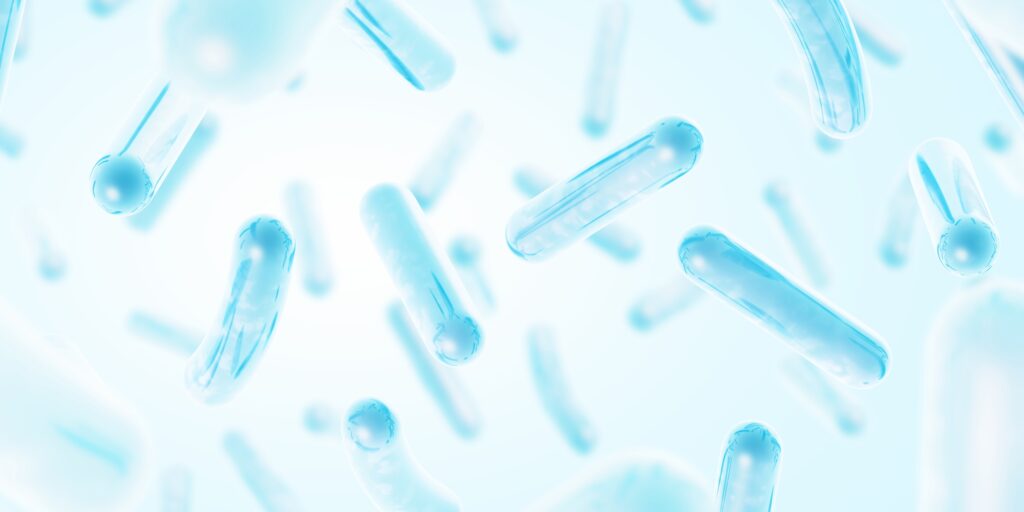In this article, we’ll explain the difference between prebiotics, probiotics, and postbiotics, how they work together, and the pros and cons of each.
What are Probiotics?
Before we get into prebiotics and postbiotics and how they work in tandem, here’s a quick refresher on probiotics.
Probiotics are friendly microorganisms found in foods, beverages, supplements, and the natural environment. 1
Their role is to inoculate the digestive system/gut microbiome, where they help support: 2
- Intestinal barrier function
- Digestion
- Elimination
- Microbiome diversity
- Immune function
- Gut-brain function
- Other facets of the various gut-organ/system axes.
Probiotics may contain one or many microorganisms and come in different forms, such as spore-form (Lactobacillus sporogenes, for example), which is more robust against stomach acid. 3
The most common probiotics are bacteria belonging to the Lactobacillus and Bifidobacterium groups.
Lactobacillus acidophilus, for example, is typically found in yogurts and other fermented foods.
Probiotics/friendly bacteria are everywhere in nature, from soil and foods to the air we breathe.
Most experts recommend consuming cultured foods, spending time outdoors, and taking supplements to increase friendly gut bacteria naturally.
What are Prebiotics?
Prebiotics are a type of fiber that resists digestion and ferments in the gut, where they act as food for probiotics.
Prebiotics are also known as resistant starch.
The scientific consensus on what types of fiber are prebiotic is ever-expanding. Here are some examples of foods known to contain prebiotic fiber of this writing: 4
- Chicory
- Dandelion greens
- Jerusalem artichokes
- Onions
- Leeks
- Asparagus
- Mushrooms
- Oats
- Bananas (especially green bananas)
- Potato starch
- Wheat
- Soybeans
Inulin and oligosaccharides are two of the most common prebiotic fibers found in supplements.
Since prebiotics are essential to the survival and proliferation of probiotics, they should always be included in high-quality probiotic supplements.
What are Postbiotics?
Postbiotics are bioactive active waste products left behind after probiotics and prebiotics are digested or fermented. 5 Think of them as a metabolic by-product.
As strange as it may sound, research suggests postbiotics may offer various benefits, including:
- Immune support 6
- Digestive support 7 8
- Microbiome support 7 9
- Metabolic support 7 10 11
- Cardiovascular support 12 13
Those who follow traditional nutrition practices may be familiar with the postbiotic butyrate, a short-chain found in dairy products from grass-fed cows and other foods.
Since postbiotics are a by-product of pro- and prebiotics, we can enhance our levels by eating more cultured and fiber-rich foods and/or taking probiotic/prebiotic supplements.
There are also a few postbiotic supplements available for targeted support.
Pros and Cons of Probiotics, Prebiotics, and Postbiotics
All three biotic cousins have been a part of human life since the beginning of time.
Babies born vaginally are inoculated with friendly bacteria from their mothers during birth.
Breastmilk and certain types of formula also contain probiotics and prebiotics, as do many kinds of foods.
And friendly microorganisms are everywhere in the natural world, such as in the soil, air, and even on our pets.
Postbiotics are naturally created by probiotic and prebiotic consumption.
Therefore, all three are considered very safe.
The most common side effects from probiotics come from eating or taking too much of them, which may include digestive upset or diarrhea.
Consuming too much resistant starch or prebiotic-rich foods can also result in digestive complaints, such as gas, bloating, abdominal pain, and changes in elimination.
Postbiotics, in the form of supplements, are considered the safest, as they do not contain any live bacteria or fiber and survive antibiotics and gastric juices.
Talk to your healthcare practitioner if you are concerned about consuming prebiotics, probiotics, or postbiotics from foods or supplements.
Should You Take A Prebiotic, Probiotic, and/or Postbiotic Supplement?
With so many gut health supplements available today, deciding on a prebiotic, probiotic, and/or postbiotic supplement can be confusing.
Generally, the best way to support your gut microbiome diversity is by eating cultured foods, avoiding over-sanitizing, reducing stress, getting enough sleep, and spending time in diverse outdoor environments.
Many health experts also recommend certain strains of probiotics with prebiotics, and sometimes postbiotics, to further support microbiome function.
The best types and combinations will depend on your body and health goals.
At the very least, look for high-quality supplements containing probiotics and prebiotics with no added sugar, flavors, dyes, fillers, preservatives, or other artificial ingredients.
Postbiotics are not always included in probiotics/prebiotic supplements, but that isn’t necessarily an indication of the quality or efficacy of the formula.
Postbiotics are a new and emerging field of research and, therefore, are not as easy to find as probiotic/prebiotic formulas.
Ultimately, check with your doctor or healthcare practitioner about the best formula.
Looking for more on the exciting new field of postbiotic research? Check out: What Are Postbiotics? for more detailed information on their benefits.
REFERENCES:
1. “Probiotics: What You Need To Know”, National Center for Complementary and Integrative Health. .
2. “Role of Probiotics in Human Health”, Cureus.
3. “Spore-forming bacteria and their utilization as probiotics”, Benef Microbes..
4. “Fiber and Prebiotics: Mechanisms and Health Benefits”, Nutrients,.
5. “Postbiotics—A Step Beyond Pre- and Probiotics”, Nutrients..
6. “Postbiotics—A Step Beyond Pre- and Probiotics”, Nutrients..
7. “Postbiotics as the key mediators of the gut microbiota-host interactions”, Le Infezioni in Medicina..
8. “The Current and Future Perspectives of Postbiotics”, Probiotics and Antimicrobial Proteins.
9. “The Current and Future Perspectives of Postbiotics”, Probiotics and Antimicrobial Proteins .
10. “The short-chain fatty acid acetate reduces appetite via a central homeostatic mechanism”, Nat Commun .
11. “Short-chain fatty acids suppress food intake by activating vagal afferent neurons”, J Nutr Biochem .
12. “Efficacy of Probiotics in Patients of Cardiovascular Disease Risk: a Systematic Review and Meta-analysis”, Curr Hypertens Rep. .
13. “Clinical Evidence on the Potential Beneficial Effects of Probiotics and Prebiotics in Cardiovascular Disease”, Int J Mol Sci .






